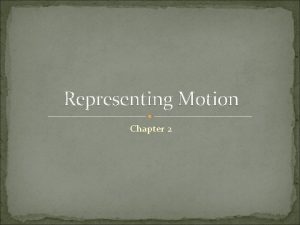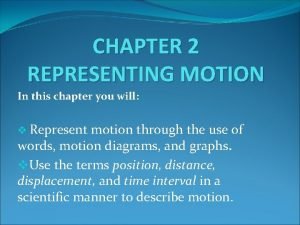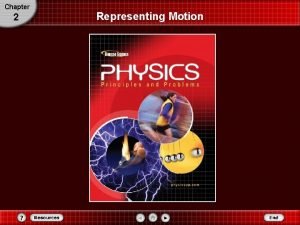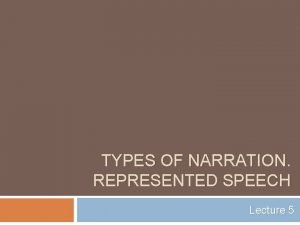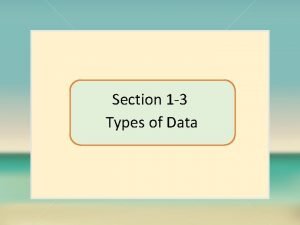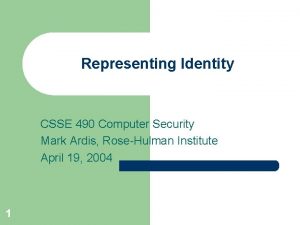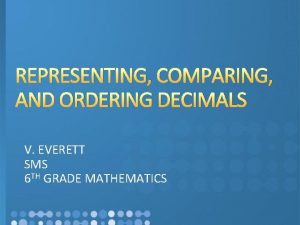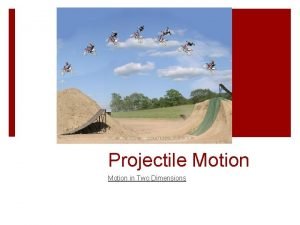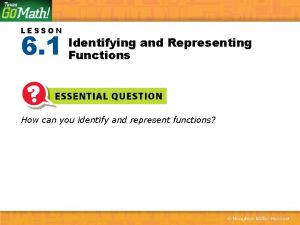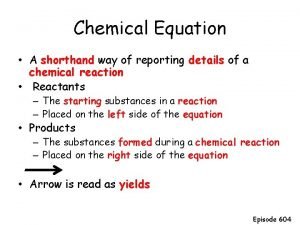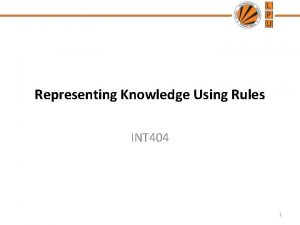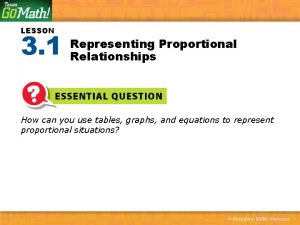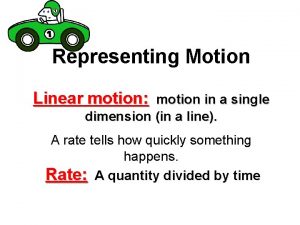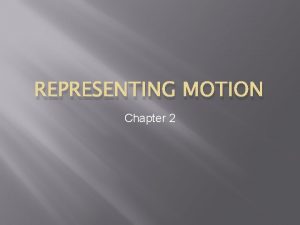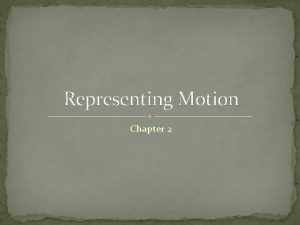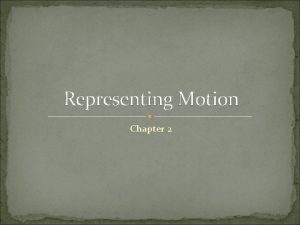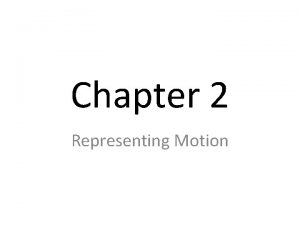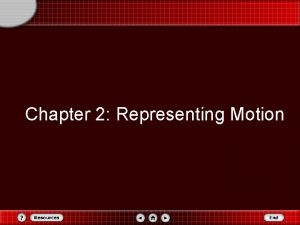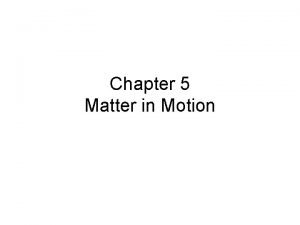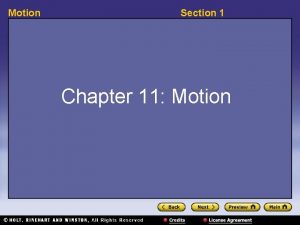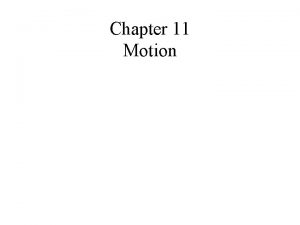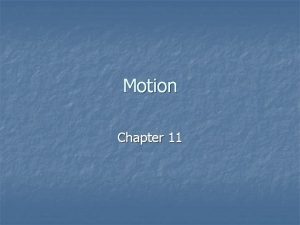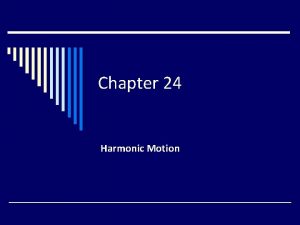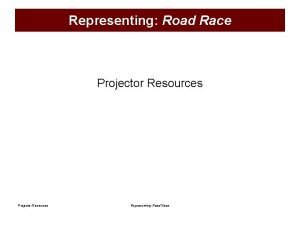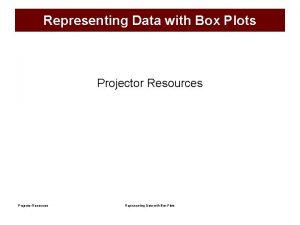Representing Motion Chapter 2 Representing Motion We will

























- Slides: 25

Representing Motion

Chapter 2 Representing Motion We will begin by studying motion in a straight line; we will eventually learn about motion in 2 dimensions (projectiles and circular motion) and vibrating objects.

2. 1 Picturing Motion • Motion diagram – a series of images showing the positions of a moving object at equal time intervals • Particle model – simplified version of a motion diagram using dots to represent the object in motion.

Motion Diagram: shows position of a moving object at equal time intervals Particle Diagram: Simplified version of the motion diagram

Motion Diagram of Bird’s Eye view Wing Tip View

Motion Diagram of a Car

The Big Race

Mechanics - Study of motion Kinematics - Description of motion Dynamics - Causes of motion Terms: distance speed displacement velocity acceleration distance - “how much ground an object has covered”

2. 2 Where and When • Coordinate system – system used to describe motion that gives the zero point location of the variable being studied and the direction in which the values of the variable increase. 0 2 4 6 8 10

• Can an object have a negative position? Yes

Vectors • vector – quantity that has magnitude and direction magnitude = size • Examples: velocity, acceleration, force • Arrows are used to represent vectors • The sum of two or more vectors is called the resultant

Scalars • Have magnitude only • Examples: mass, temperature, time

Scalar quantity any quantity that only has magnitude ( amount) Examples: scalar vector distance displacement velocity acceleration time temperature mass volume speed density

Time Interval t • t is used to represent time • t is the change between two times • t = tf – ti • Usually, initial time is zero.

Displacement d • d is used to represent position • d is the change between two positions • d = df – di • Usually, initial position is zero.

displacement: change in position 2 m S 3 m S 5 m. S displacement includes direction (vector quantity) Any quantity that includes direction to be completely described

displacement is not the same as distance 4 m S 3 m N distance = displacement = 7 m 1 m S 1 m. S

Other directions: 3 m right 4 m left + 3 m -4 m Signs may also me used + Right , up, North - Left, down, South 5 m up 2 m down +5 m -2 m

displacement = change in position = final position – initial position Δd = df - di 10 20 30 xi=20 cm Δd = df - di Δd = 55. 00 cm – 20. 00 cm or 35 cm right 40 50 60 xf=55 cm cm

10 20 xf=20 cm or 25 cm left 30 40 50 xi=45 cm 60 cm

Only the initial position and the final position is important. A bug travels from the 45 cm mark to the 60 cm and then to the 5 cm and ends at the 20 cm mark.

y is used instead of x Vertical displacement 60 50 yf 40 = +40 cm or 40 cm up 30 20 10 yi

Final displacement may also be found by adding displacements (with direction included) 0 2 3 Bug travels 30 cm right, finally 10 cm right. 1 then 20 cm left and +30 cm + (-20 cm) + 10 cm = + 20 cm or 20 cm right

2. 3 Position-Time Graphs • Plot time data on horizontal (x) axis • Plot position data on vertical (y) axis Pg 39 #9, 11 Pg 41 #14 - 18

• (go to “describing motion with graphs” ppt)
 Representing motion physics answers chapter 2
Representing motion physics answers chapter 2 Representing motion
Representing motion Chapter 2 representing motion
Chapter 2 representing motion Representing motion
Representing motion Chapter 2 motion section 1 describing motion answer key
Chapter 2 motion section 1 describing motion answer key Describing and measuring motion
Describing and measuring motion Section 1 describing motion answer key
Section 1 describing motion answer key What is active range of motion
What is active range of motion Simple harmonic motion equation
Simple harmonic motion equation An object in motion stays in motion
An object in motion stays in motion Describing and measuring motion worksheet answer key
Describing and measuring motion worksheet answer key Motion section 1 describing motion
Motion section 1 describing motion Entrusted narrative
Entrusted narrative Statistic vs parameter example
Statistic vs parameter example Representing identity in information security
Representing identity in information security Representing comparing and ordering decimals
Representing comparing and ordering decimals Draw vector arrows representing the vx and vy brainly
Draw vector arrows representing the vx and vy brainly Soe definition floral design
Soe definition floral design Lesson 6-1 identifying and representing functions
Lesson 6-1 identifying and representing functions Chinese symbol for chaos
Chinese symbol for chaos Chemist shorthand way of representing chemical reaction
Chemist shorthand way of representing chemical reaction A shorthand way to represent a molecule
A shorthand way to represent a molecule Shorthand way of representing chemical reaction
Shorthand way of representing chemical reaction Representing knowledge using rules
Representing knowledge using rules Symmetric relation
Symmetric relation Representing proportional relationships
Representing proportional relationships

